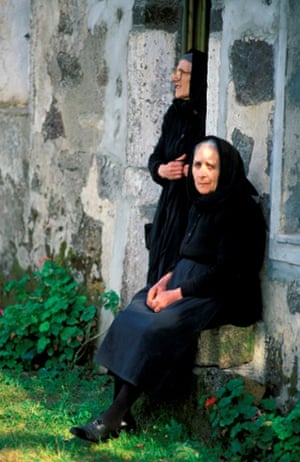From: The Guardian
In villages in Sardinia, 10 times as many men live past 100 than the average. Why? A key reason is that they are not lonely. Psychologist Susan Pinker on the importance of face-to-face contact in our era of disbanded families and virtual connections

Last month the Church of England asserted that a big slice of British society feels “unwanted, unvalued and unnoticed”, a view confirmed by recent population surveys. A third of British citizens over 65 now say that they have no one to turn to, and a significant swath of those under 25 say they also feel disconnected from the people around them. Has loneliness become the new normal?
As you start humming the chorus to “Eleanor Rigby”, realise this: feeling untethered is not only uncomfortable, it is bad for your health. Research shows that people who feel socially disconnected are at a greater risk of dying young – especially if they are men. Women are more prone to seek out and build longstanding, intimate personal relationships: within their extended families, through lifelong friendships, in their neighbourhoods.
That is one reason – there are others, of course – why in every industrialised country, women outlive men by an average of five to seven years. This gender imbalance is visible wherever older people spend their time; in parks, libraries, churches, community halls and seniors’ tour groups, women over the age of 60 outnumber men in their age group by three to one.
But this is not the case everywhere. There is one place in Europe where both sexes are living long lives. It is an area where, for better or worse, no one is left alone for very long. In what has been dubbed the Age of Loneliness, it’s worth asking what they have that we don’t.
***
The residents of the hilltop villages of central Sardinia are among the world’s only exceptions to the rule that women in developed nations live longer than men. Almost everywhere else, including on the Italian mainland 120 miles away, there are six female centenarians for every male. Elsewhere, most men don’t make it to 80. But once Sardinian men in this region have survived their dangerous, risk-taking adolescent and young adult years, they often live as long as their wives and sisters – well into their 90s and beyond; 10 times as many men in these villages live past the age of 100 as men who live elsewhere. Despite living hardscrabble lives as shepherds, farmers and labourers in an inhospitable environment, Sardinians who were born and live in these villages are outlasting their fellow citizens in Europe and North America by as many as two to three decades. Many of these centenarians remain active, working well into their 90s and living in their own homes, usually with the help of people they’ve known their entire lives.
These villages comprise one of the world’s “Blue Zones” – a handful of mountainous regions where more people live to the age of 100 than anywhere else. This zone has nearly the same landmass as Switzerland but with less than a quarter of its population; just 1.5 million people live in the towns dotting the rugged shoreline and pastoral mountain villages in the Ogliastra region, the epicentre of the Sardinian Blue Zone. Centuries of invaders and regular attacks from North African pirates drove residents away from the coast inland, beyond the rugged Gennargentu mountains. This geographic isolation bonded the area’s families and communities. That is the upside. The downside is that always having to defend your boundaries created a longstanding mistrust of strangers, aptly illustrated by the local saying Furat chie benit dae su mare: those who come from the sea come to steal.

That hostility to outsiders is one reason why I flew into Alghero – a Moorish-looking seaside town with an airport and a university – instead of heading straight to the Blue Zone. I was travelling with my daughter Eva, to record the life stories of these centenarians for a radio documentary. Our first step was to meet an expert in Sardinian super-longevity, a local physician and biomedical researcher named Giovanni Pes, accompanied by a geneticist colleague, Paolo Francalacci, who told us that genes account for perhaps 25% of the variance that leads to male super-longevity in the region; culture and chance accounted for the rest.
Pes immediately included us in his lively circle of close friends, family and colleagues, and this sense of inclusion turned out to be a crucial piece of the longevity puzzle. Every centenarian we met was supported by kith and kin, visitors who stopped by to chat, bring food and gossip, provide personal care, a kiss on the cheek. Time-pressured grown-up children, grandchildren, nieces and nephews – some of them senior citizens themselves – took time off from work to look after their elderly family members.
Despite a packed clinical and research schedule, Pes told me it was normal to spend every Sunday with his mother. “Of course we have to balance our careers with family life,” he told me. “But as a Sardinian, I never forget to visit my mother. She lives 70km from me, but every week I visit her. She is 87 now but is fantastic mentally. I talk to her about my work at the university and she always gives me interesting advice.”
Given that his father lived to 105 and his great-uncle to 110 and that the biology of ageing has inspired his research career, Pes is well versed in the multiple conditions that foster extraordinary longevity in Sardinia: the isolated gene pool, the mountainous terrain, the local diet and red wine. But he also emphasises the buffering effect of social factors – the impact of face-to-face interaction which is so central to Sardinian village life. “Everybody is in close contact with other members of the community. My great-uncle was no exception. He used to visit friends and relatives and was fond of going hunting until he was 98 years old. And if I remember correctly, he was able to shoot a wild boar at that age.”
Caring for fragile relatives seems motivated by more than duty. Obligation is mixed with pride, a sense of ownership and identity. The contrast to how families behave elsewhere is stark. In other parts of Europe and in North America, looking after ageing family members can be seen as grunt work. Yet when I asked Maria Corrias, a woman in her 60s who lived with, and cared for, her nearly deaf, housebound, irascible, 102-year-old uncle if she felt frustrated by her situation, she became annoyed with me. “No, no! I do it with pleasure. You don’t understand. He is my heritage. The seniors of this village are our heritage. We do it with love.” I asked her 25-year-old niece, Sarah, if she would do the same for her elderly relatives when the time comes. “Certo, of course I will,” she replied. “Everybody does it.”
***
Our survival hinges on social interaction, and that is not only true of the murky evolutionary past. Over the last decade huge population studies have shown that social integration — the feeling of being part of a cohesive group — fosters immunity and resilience. How accepted and supported we feel affects the biological pathways that skew the genetic expression of a disease, while feeling isolated “leaves a loneliness imprint” on every cell, says the American social neuroscientist John Cacioppo. Women with breast cancer who have expansive, active, face-to-face social networks, for example, are four times as likely to survive their illness as women with sparser social connections. How might that work? Research led by Steve Cole at the University of California, Los Angeles shows that social contact switches on and off genes that regulate the rate of tumour growth (and the level of cancer-killing lymphocytes in our bloodstreams).
Fifty-year-old men with active friendships are less likely to have heart attacks than more solitary men, and people who have had a stroke are better protected from grave complications by an in-person social network than they are by medication. Working with a large British sample, the Australian researchers Catherine and Alex Haslam have found that people with active social lives recover faster after an illness than those who are solitary – their MRIs show greater tissue repair – and that older people in England who participated in social gatherings kept their memories longer.
And it’s not just about pensioners. When the daily habits of nearly 17,000 utility workers in France were monitored throughout the 1990s, researchers discovered that their degree of social involvement was a good way to predict who would still be alive at the end of the decade.
The studies on the benefits of face-to-face social contact, almost all of them published during the last decade, leave us with the question: why isn’t there more buzz about getting together? One reason is that when it comes to what drives health and happiness, we’re obsessed with more concrete concerns: food, money, exercise, drugs. We recognise that cigarettes, salt, animal fat and being overweight can shorten our lifespan, while antibiotics, physical activity and the right diet can prolong it. This knowledge has changed the way most of us eat, work and spend our leisure time. But despite evidence that confirms the transformative power of social contact, our routines have become more solitary. Since the late 80s, when social isolation was first earmarked as a risk for premature death in a landmark article in Science magazine, the number of people who say they feel isolated has doubled if not trebled, according to population surveys in Europe, the US and Australia.

The questions how and why loneliness has increased have been much debated.Communities have disbanded for a variety of reasons. And while the internet allows us to ignore geography in our search for the like-minded, it has further stripped away the need to talk to our neighbours. Most commercial and social transactions have migrated online, where they’re cheaper and quicker, and for many people, the workplace and the classroom are now virtual, too. If electronic media informs and entertain us, who needs all that forced person-to-person chit-chat?
Certainly digital computation has eclipsed raw brain power when it comes to searching, gathering and sorting information. But when it comes to relationships, our electronic devices can give us the illusion of intimacy without the hormonal rush of the real deal.
In 2012, the University of Wisconsin psychologist Leslie Seltzer and her team asked pre‑teen girls to solve maths and word problems in front of an audience. Before testing them, the researchers measured the participants’ salivary cortisol, a hormone that registers levels of stress. They were then divided into four groups. Each received a different type of social contact immediately after the test: one quarter of the group had a visit from their mother, one quarter got a phone call from her, one quarter an encouraging text, and one quarter had no communication at all. After the test, the cortisol levels were measured once again, along with the levels of oxytocin in the blood. The girls who saw their mothers in person became the most relaxed afterwards, as shown by the biggest drop in their cortisol levels. A spike in oxytocin, often called the “cuddle chemical”, showed they felt reassured. That phenomenon, though attenuated, was shown in girls who heard their mother’s voice on the phone. But a text from their mother had no impact. There were no physiological signs that the participants felt less anxiety than they had before. Indeed, their hormone levels were indistinguishable from the girls who had no contact at all.
Recent MRI studies led by neuroscientist Elizabeth Redcay tell us that personal contact elicits greater activity in brain areas linked to social problem-solving, attention and reward than a remote connection. When the identical information is transmitted via a recording, something gets lost.
Just as we all require food, water and sleep to survive, we all need genuine human contact. Digital devices are great for sharing information, but not great for deepening human connections and a sense of belonging. More socially cohesive societies – such as the Blue Zone of Sardinia – suggest that we should use our mobile devices to augment, not to replace, face-to-face interaction – that is, if we want to live longer, healthier and happier lives.
Britons of all ages now devote more time to digital devices and screens than to any other activity except sleeping; a lot of those hours are spent alone. No app exists that is as effective as one year with a highly trained teacher, or the cumulative effect of regular family meals spent together.
A quarter of Britons now say they feel emotionally unconnected to others, and a third do not feel connected to the wider community. If men are to live as long as women, if urbanites hope to live as long as Mediterranean village dwellers, they need to live in a place where they know and talk to their neighbours. But there is no need to trash your smartphone and move to rural Sardinia. Once you recognise that you need more than pixelated, electronic ties, and more than a handful of close friends and family to keep you healthy and happy, you can stay where you are. By cultivating a community of diverse, person-to-person relationships, you can build your own village, right where you live.
• Susan Pinker’s The Village Effect: Why Face-to-Face Contact Matters is published by Atlantic.
No comments:
Post a Comment